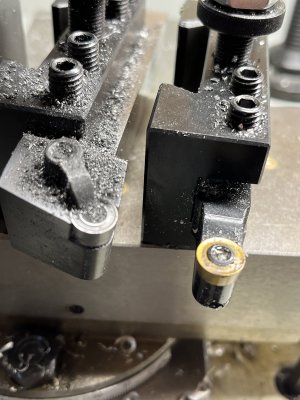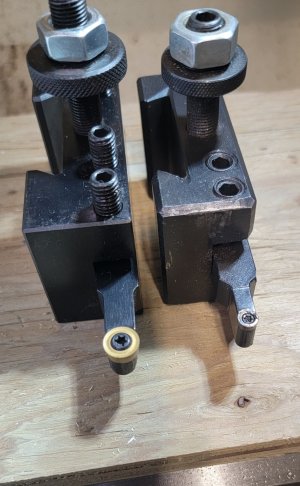What speeds (approximate range) do you typically use when using inserts?
I figure most here are machining more mild steels, so I will start with that.
I generally run most inserts in the 400-1800RPM range on a manual lathe. Simply because we can't feed it consistently like a CNC lathe could, therefore, you generate more heat and wear on the inserts. Having said that, it will work really well with the proper grade inserts for both roughing and finishing.
You want to keep the heat in the chips... The tool needs to stay as cool as you can keep it ( not hot to the touch, warm is where your tool will be most of the time cutting) as well as the bar stock. Use air or coolant, I prefer air.
Why air manually? Carbide does not like heat or inconsistencies (chip load-feed) Therefore, carbide inserts want to crack and wear quickly when you apply coolants to them. If your semi finishing or finishing coolant will be ok since your not generating much heat at that point and your only taking .02 semi and .012-.015 for finishing.
When choosing inserts, you want a decent radius for roughing ( At least .03r on any insert you choose) . I use triangular inserts 85% of the time I would say.
Now, Shell mill inserts as shown above by @Susquach. They are amazing for ruffing in all types of steels. They will eat A2, D2, PH4140, P20, H13 , 01... that tool will take it no problem. Nice dish for chip breaking and flat top inserts work really well too in that style of insert. Keep the RPMS around 900 unless you can really feed it. Don't go heavy, just take .03 DOC's and the insets will last.
Lets try machining something in airplane mode here,
We will begin with a 2" diameter bar of HRS with a stick-out of no more than 6"- no tail stock hole since we will face only.
Lets take DavidR8's tool, inserts and go at it.
Thanks David, we will pay it forward, I promise!
Since we are starting out with only 1 style insert with a .015r, we need to keep the RPMS up a bit for roughing with it, kinda backwards to what we should do, but, I don't have the keys to David's tool box just yet to see if we could use something else.
Now because of the .015r, that tells us this is a semi finishing/finishing grade carbide insert (we won't get into the coating this time. Why, because it will heat up so quick the coating will be gone in minutes manually machining). Having said that, we know now, this insert and coating does not like heat at anytime, it will turn its nose up and down with heat until it wears down quickly. Using air or coolant, those inserts will wear rather quickly. Too much heat then add coolant, they will just crack. Carbide inserts need consistency for the most part. The more expensive inserts can withstand much more abuse in manual machining, they have much better coating and tougher grades of carbide.
Lets start roughing...
We will set the RPMS to 750 for our first pass in the 2" diameter HRS bar stock with a stickout of 6" Take .025 feeding slowly with air ( Coolant up to you I would stick with air until finishing )
The insert will now have some wear due to the radius and coating. It will be black around the nose and all around its face. Nothing we can do about it, keep it for skimming the next 1.
Now since that insert has been " heat cycled " and their are other good corners, lets keep that 1 aside for just skimming HRS and the like going forward.
@DavidR8.. We need the keys to your tool box soon lol...
Lets put another insert in since the scale and first .025 depth was a bugger to get through with that insert.
On a side note, for the hobby guys.
A nice HSS cutter, nicely ground with relief would have done just a good a job at 80-110 rpm with 2 passes at .015
Unfortunately, for new guys, grinding cutters and adding reliefs is not something you can learn so quickly.
Insert changes are quick and make results instantly. That's the trade off.
Lets try bumping it up to 1200RPM for semi finishing only taking light passes of .015-.02 max doc with this insert feeding it rather quickly for a nice chip color, Lets take it down to 1.890 leaving us with about .015 give or take. We will finish the last .015 in 2 passes, I mic and split the difference here.
After semi, pull the insert out, put it aside... This will be your semi finishing insert for some time now (hopefully)
Throw in another insert. Don't turn it, put another 1 in, Keep it for finishing.
Lets go to 1800RPM, for the finishing pass, add coolant or WD-40 or what ever flavor oil you like. Amsoil synthetic works too.
A little bit of emery paper to clean up the insert marks if you left any, although it should be a nice finish since we swapped out inserts.
Final note,
When you buy cheaper inserts etc, try to keep track of the lots numbers, this will help when you find yourself stuck as to why the new box of inserts isn't cutting as well as the last 1's did.
I have never done a write up like this in my lifetime, so, it certainly isn't perfect, but will get you pretty darn close guys.
Time to make twin paper rocket, my brain hurts now.
Hope this helps a bit!


